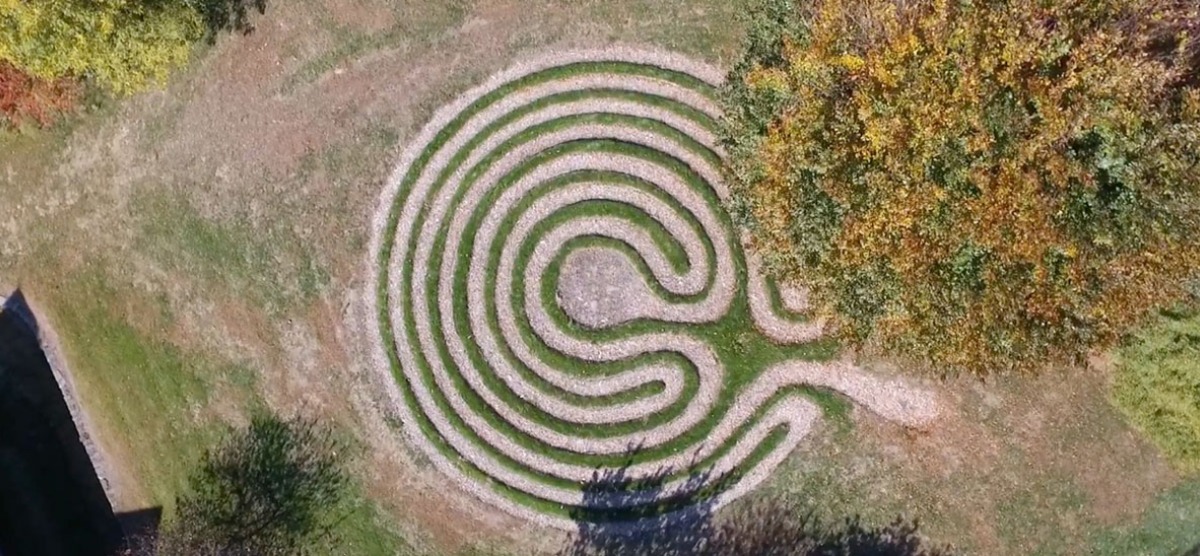
Revisiting the Eternal Labyrinth
A special space for campus reflection and contemplation turns 20
On May Day 1999, the McBride Scholars gifted The Labyrinth to the College community. In honor of its 20th anniversary, we are republishing this piece by Salomon, a McBride alumna and creator of The Labyrinth. This writing originally appeared in the Spring 2000 issue of the Bryn Mawr Alumnae Bulletin. The author has contributed a new postscript following the article from two decades ago.
As a place of learning, Bryn Mawr speaks of Being and Becoming. The labyrinth, invented by prehistoric cultures more in tune with the mysteries of Life, addresses Being and Becoming as related aspects of reality. In the daily reality of student life, Being and Becoming translate into existence and transformation in time. While college education emphasizes the analytical and rational mode of consciousness and the importance of linear time, it tends to neglect the intuitive, spiritual level of human awareness.
The labyrinth offers suspension of time and its inherent directionality and thus allows for contemplation and meditation. We are prompted to slow down to follow the path as it turns in and out to lead us into the center and out again on the way. We can muse, contemplate, dream, ask questions, provide answers, breathe, quiet the chatter inside, and become silent and amazed.
The labyrinth is an ancient symbol that engages the eye and the mind. The classical design, consisting of seven rings of paths within eight concentric walls, is the most common and universal throughout history. We find it in petroglyphs around the world: it decorates clay shards in Syria and appears as graffiti on pillars in Pompeii and on Roman pavements. We see it in South American line drawings as well as in turf labyrinths in Northern Europe.
Through the millennia, labyrinths have served many needs. The earliest appear to be mystical, symbolizing the riddle of life, birth, death and reincarnation. Today, at this crucial time in history when we are in desperate need of a symbol for wholeness, human consciousness remembers the archetypal labyrinth as a way of knowing.
Bringing the labyrinth to the Bryn Mawr campus involved many steps. First, we had to find a suitable site and develop a low-maintenance and low-cost design. Campus horticulturalist Robert Burton and I looked at three possible sites. The knoll between Canaday Library and Rhoads dormitory, overlooking Shillingford Field, proved not only beautiful and suitable but also perfect: when I checked the site with my dowsing rods, the knoll itself and the majestic trees surrounding it gave permission for the labyrinth to come into existence. The next step concerned the right location of the labyrinth, and by dowsing the area, I found energy leys and a water dome with incoming and outgoing veins — a characteristic of many ancient sacred sites. The center of the labyrinth is situated where energy leys and a water dome converge.
In April of 1998, I spray-painted a temporary classical seven-circle labyrinth design on the grass. That summer, Mr. Burton and I observed the setting and contemplated the dimensions for the final design and the materials to be used. Once the McBride Scholars accepted my suggestion to offer the labyrinth as a gift to the college, I went ahead and, assisted by Mr. Burton, implemented the plan for the permanent labyrinth. In early September, I marked out the final 66-foot diameter design. In late November, in a combined effort of McBride Scholars, traditional students, a worker from the grounds department, and Mr. Burton with his daughters, we cut the labyrinth’s path, removed the grass sod, and covered the path with woodchips. In the grassy area between the circles of the meandering path, we planted thousands of crocus and tulip bulbs for a colorful spring display. The labyrinth complements and completes the inventory of walled, sunken, and woodland gardens on campus.
On May Day 1999, President Nancy J. Vickers accepted the labyrinth as a gift from the McBride Scholars to Bryn Mawr College. Spontaneously, it was incorporated into the college's traditions and was put to use in a ritual for graduating McBride Scholars. It is registered with The Labyrinth Society, Inc. in New Canaan, Connecticut, an international organization and resource.
Many students have discovered the labyrinth’s value for meditation, and they use it especially before exams and final papers to calm down and center themselves. The labyrinth proves itself as an ancient tool to connect with wisdom beyond and within ourselves. We are made aware of the process of Being and Becoming, and with this awareness, we may stride creatively and compassionately into life and into the 21st century.
Post Scriptum, April 2019
Still so true, after 20 years.
And now, nearly two decennia into the 21st century, we can find the labyrinth as a mainstream tool for contemplation and walking meditation, as a place for ritual, even as a gardenscape to grow medicinal herbs.
Together with my partner, I have created many more labyrinths over the years, private ones and ones for public use (hospital, university, tribal lands, i.e.). Like all labyrinths, they are loved in their various iterations.
In my shamanic practice, when appropriate, I ask clients to walk the labyrinth on our property; this allows people to center their thoughts on healing and, subsequently, to release all worries and concerns — around outcome of treatment — to the universe, the greater powers.
I mentioned the Bryn Mawr labyrinth in my doctoral/Ph.D. dissertation and in my recently released book, SOUL MATTERS: Modern Science Confirming Ancient Wisdom — Healing at the Interface of Spirit and Matter.
Dr. Jeanne-Rachel Salomon studied anthropology and then quantum medicine, receiving her doctorate and Ph.D. in natural medicine. She has studied with indigenous shamans and Western healers and has 20 years’ experience as a shamanic practitioner, focusing on soul retrieval for trauma resolution. She can be reached at dr_salomon@aol.com. Learn more at www.shamanicteachers.com.
Published on: 04/26/2019
